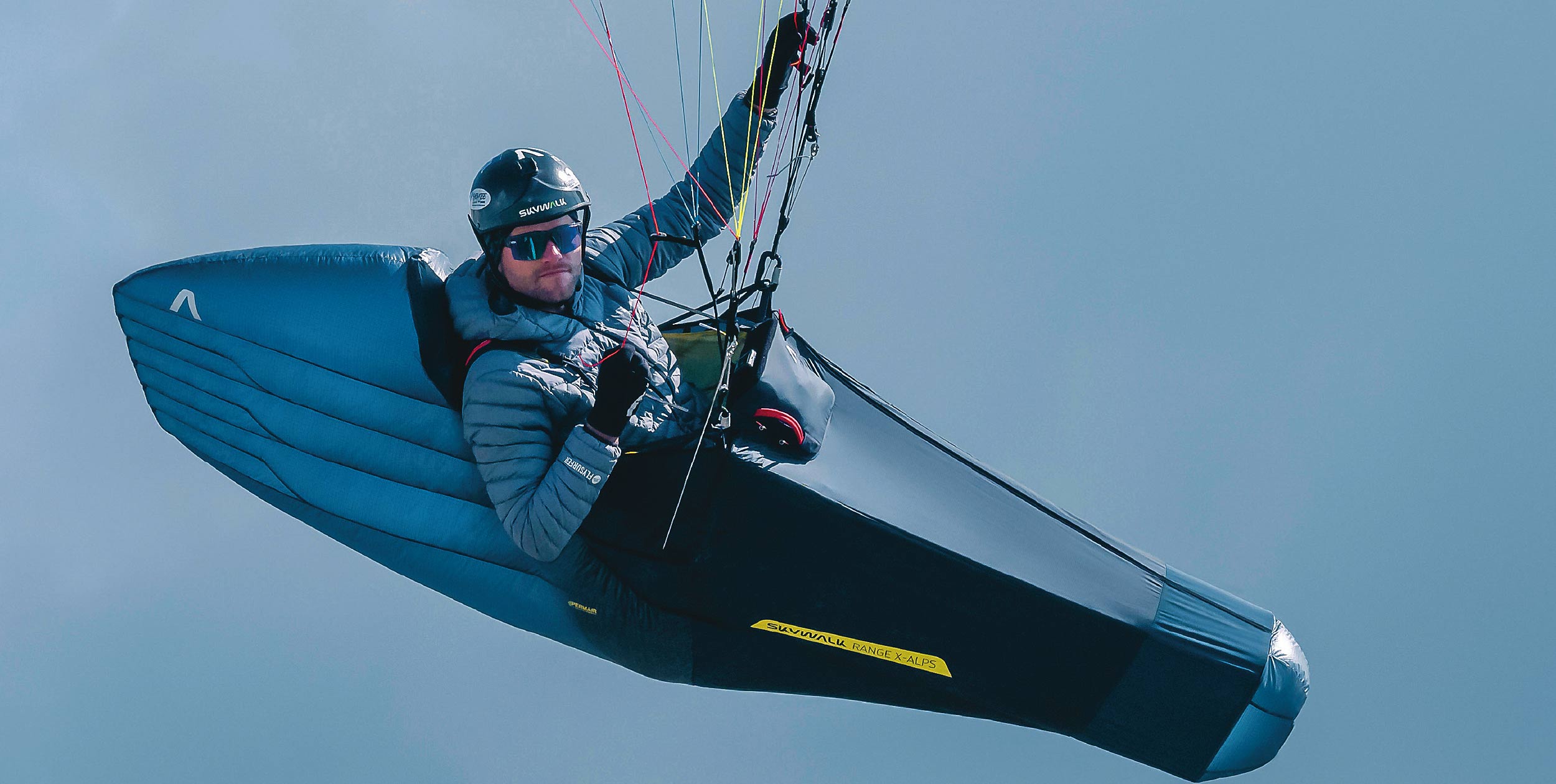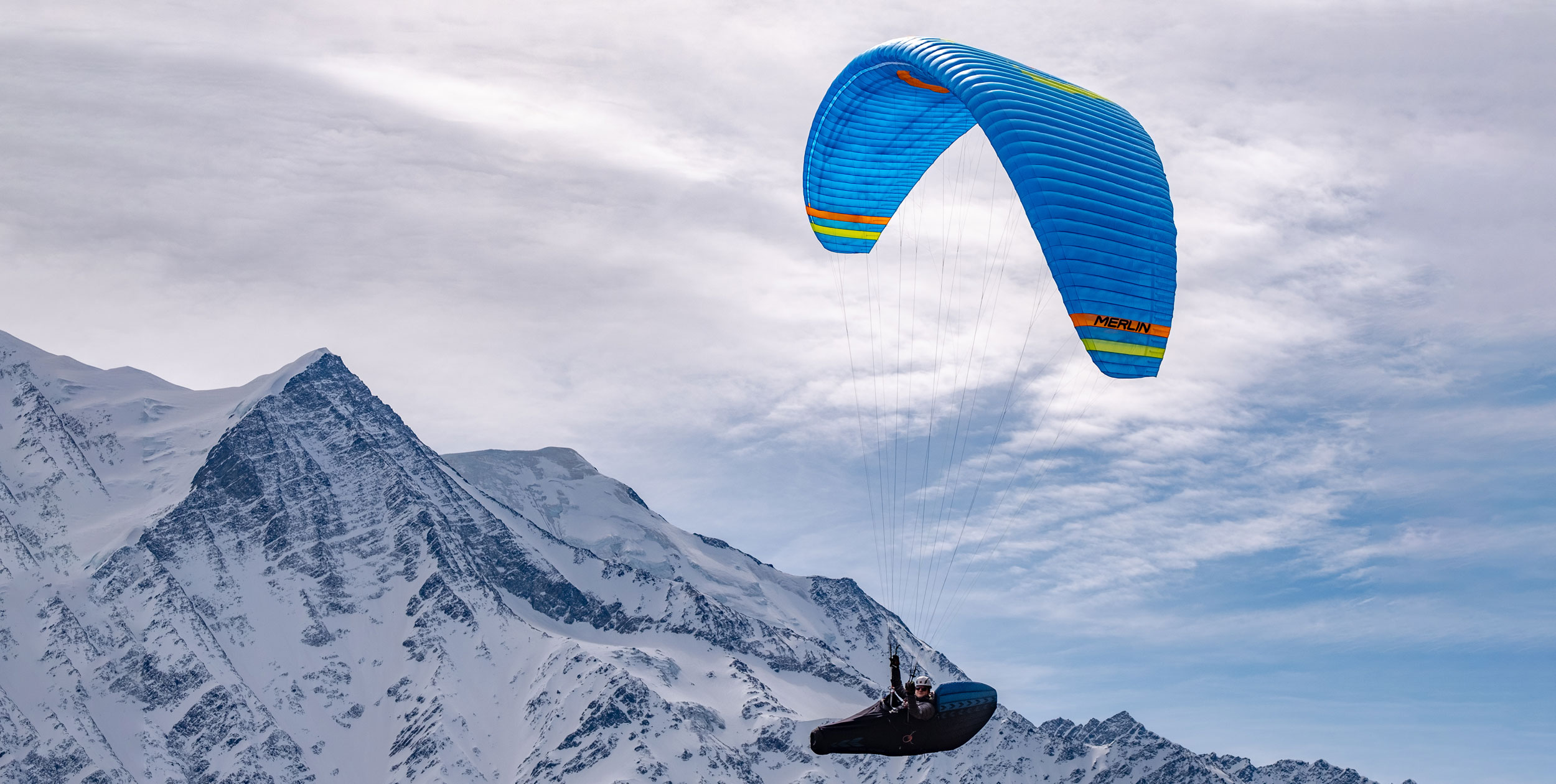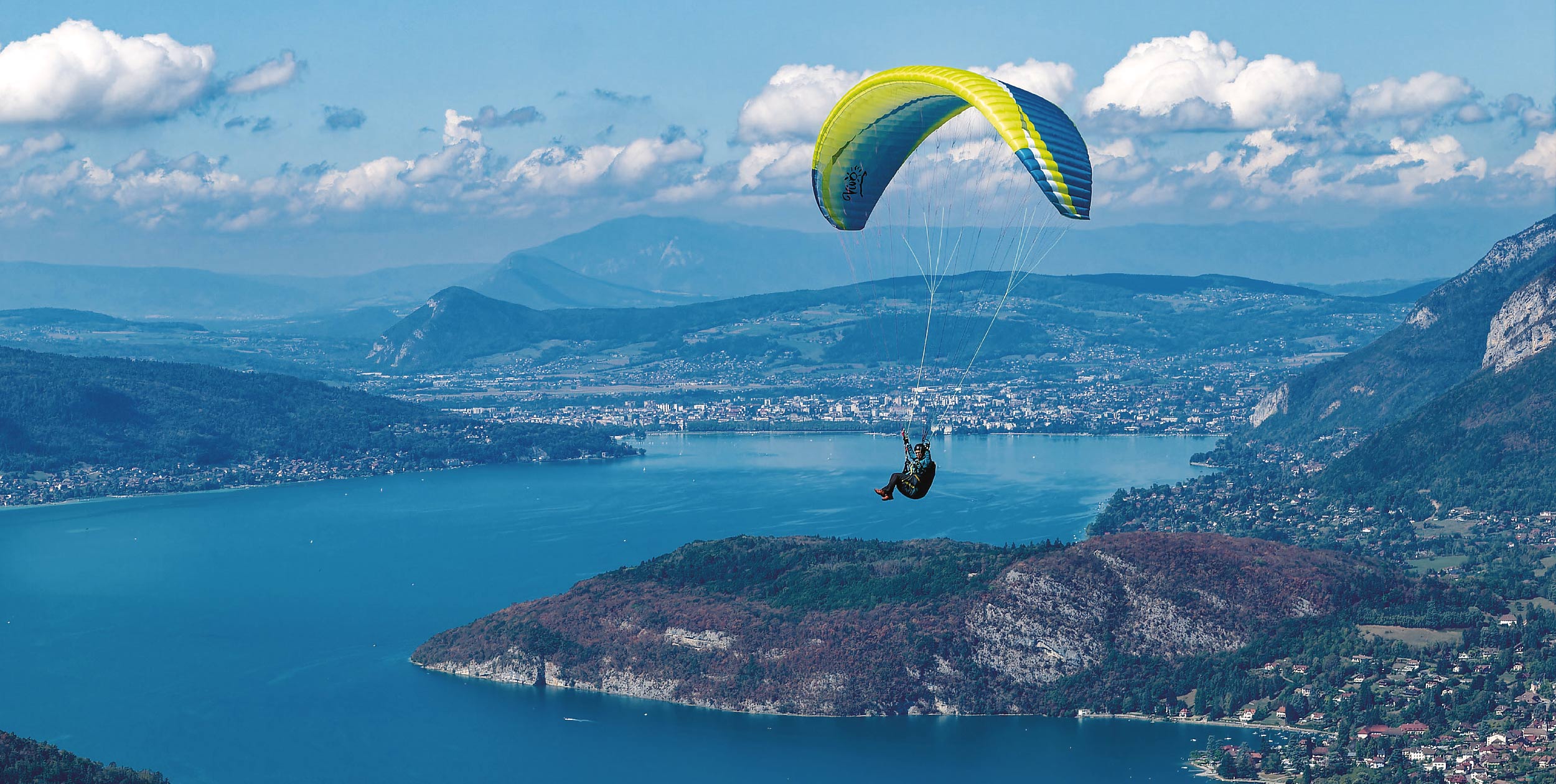Charlie King reviews this mini wing from Sky.
Ten-second review
Built to be a robust, fly multi-purpose aerial toy that, depending on wing loading, can be used for high-wind soaring, hike-and-fly or local thermalling it’s loads of fun and hits its brief. Load tested only.
Background
Zoe means ‘life’ in Greek and this wing is all about life and fun. Sky team pilot Artoosh Ghofoorian says, “Zoe for me is like a beautiful toy that you can use in many ways. It can be your first fast and dynamic glider, it can be your soaring machine, it can be a nice wing for hike-and-fly.” Sky’s social media shows Zoes being thrown around on snow slopes, on the dunes, wing-walking on each other at the seaside. You can foot-launch it, ski-launch it, throw it in a bag and take it on adventures.
Design
Sky categorise the Zoe as a mini wing. There are 13 and 15m versions in the pipeline, but at the time of writing their website confirms four currently available sizes ranging from 17m² (55-89kg) to 23m² (74-119kg) with ‘thermal’, ‘hike-and-fly’ and ‘mini wing’ weight ranges. It’s available in standard and light versions. The light version is made of Dokdo N20 and is around three-quarters of the weight of the standard, which is made from Porcher Skytex 27 with 32 on the leading edge (like the larger Pi 3 sizes). The 19m² is 2.25kg in the lightweight version or 2.85kg in the standard. Trimmers are available as an option on either version, but are recommended only for experienced pilots.
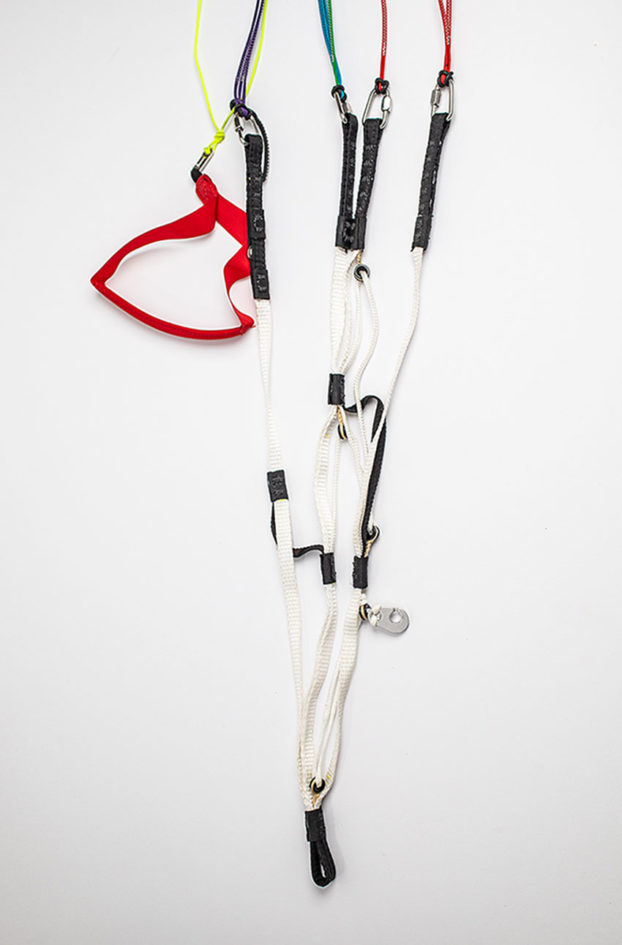
Lightweight risers
According to Sky’s specs the 17 (55-89kg) is the ideal size for me, and I chose the lightweight version initially; they then offered to send me a standard wing as well, so I thought it would be interesting to try the 19 to compare. I’m only just in its weight range but it’s a size I like for hike-and-fly wings, so I was curious to see how it differed. Looks-wise, the Zoe’s design is simple but striking, with a big ‘S’ on the top surface and a whole range of bright colours. I liked both the colours of the test wings (Guacomole and Kingstone). If none of the ten colour options Sky have created do it for you, you could design your own from their palette of 6 (lightweight) or 8 (standard) colours.
The Zoe has just 27 cells (compared to the Pi 3’s 38) and short, sheathed lines, even on the light version, which makes it feel nice and simple. The A’s are split, and both versions have poppers on the brake handles. The lightweight version has skinny ‘tape’-style risers with red ribbons for brake handles and tiny low-friction rings for the speed system. The standard risers are narrow webbing with chunky speedbar pulleys, metal maillons with plastic fillers, and comfortable fabric brake handles with poppers.
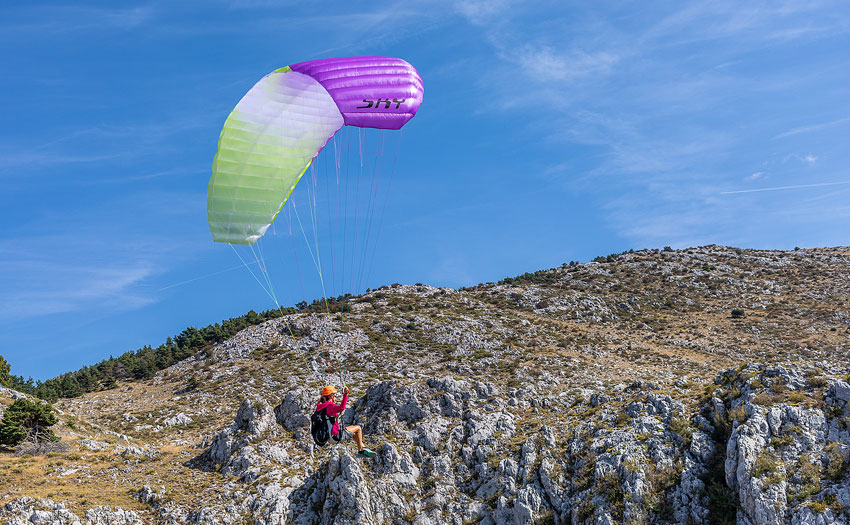
The lightweight 17m2 version
In flight
The 17, flown at 61kg all up, launched beautifully every time, the canopy rising perfectly in the lightest of winds. It was easy to forward-launch even with backwind, and despite its small size there was no reluctance to lift off. It’s also very manageable to reverse launch, easily stabilising above your head. In the air it was fast, zippy and fun. Turns could be quick and dynamic, so much fun to play around on. I had a play with some small wingover-ettes on my first flight, and they got surprisingly big, surprisingly easily. Considering the 17 can be loaded up to 89kg, I think at max. weight and in experienced hands, this wing will deliver all the thrills you could want. I can totally see how you could get addicted to the energy!
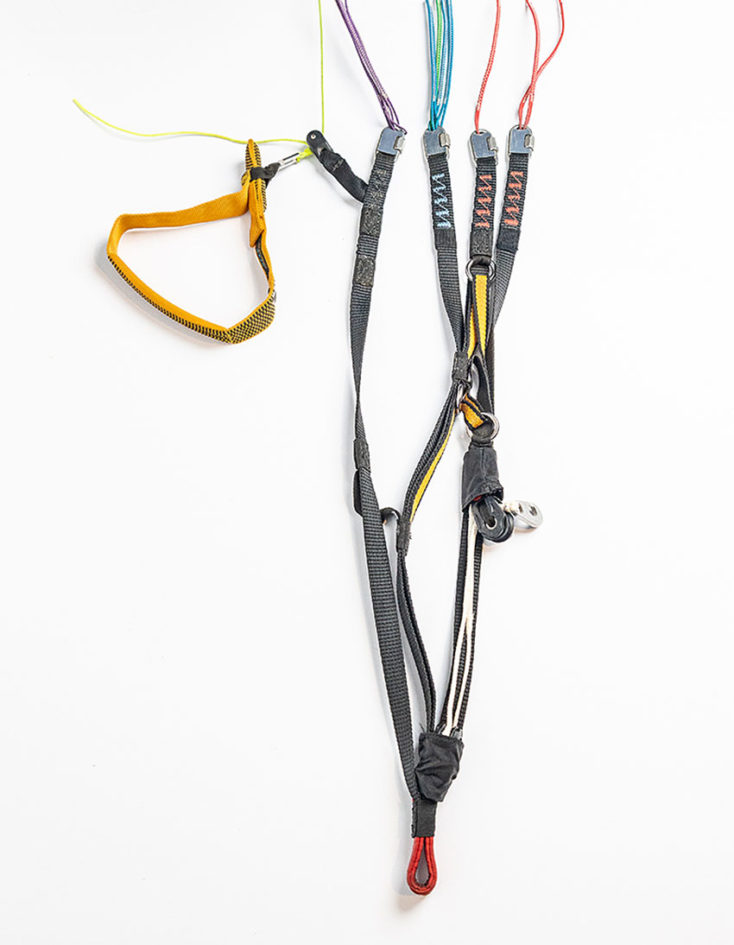
Standard risers
I did come in a bit faster than intended in a windless landing field on my first flight and didn’t do a deep enough flare – the brake travel to stall point is long and there is room for a deep flare. I then had lots of fun groundhandling it in the landing field. It comes up easily without even touching the A’s, and is easy to steer as it rises.
The 19 arrived, fresh from its beach photoshoot with a little bit of sand in the cells, ready to play. Like a child with chocolate round its face, it was a sign it had been having fun. I’d flown the Pi 3 in between the Zoe 17 and this, and it felt kind of chunky and robust in comparison. It’s made from Skytex 27, same as the larger Pi sizes, but I guess it’s something about its larger cells, the slightly more squat shape (4.2 vs 4.5 aspect ratio) and the sheathed lines that gave the impression of a more simple, robust glider that was just ready to play.
At 3.05kg it’s certainly heavier than the Pi 3 (2.15kg) but for a hike-and-fly on my local hill I didn’t really notice on the carry-up, and I really enjoyed its relative ruggedness. Our hillsides are strewn with rocks and bushes, and plants with catchy roots. It was a joy to not have to worry about catching lines, and the sail came up just as easily as the lighter version for stress-free launches. I didn’t fly it in really thermic conditions, but had fun trying to stay up in the early-morning beginnings of thermals. It’s comfortable, small and nippy and it turns nicely.
Sky intend the Zoe to be loaded up for dynamic fun, which is why the 17 is the recommended size for me. The 19 was a little less dynamic, maybe a bit less quick (in comparison) but plenty enough for me and if I hadn’t seen the specs, I wouldn’t say it felt too big. I’d describe the handling as fun, lively and direct. I’d happily keep either size for hike-and-fly. If I were buying I’d probably take the smaller size to save weight, but I enjoyed the handling of both. It depends what you want it for.
The verdict
I agree with Artoosh’s summary that it’s a wing with many sides. I loved the Zoe for its simplicity, ease of use and fun factor as a gentle hike-and-fly tool, which is my thing. The sheathed lines are easy to manage and don’t snag easily on our take-offs; you can lay it out (quite badly) in small spaces, and it will launch easily even in a slight tailwind. It’s easy, launches reliably, feels safe and forgiving. But I can see its appeal for adrenaline-freaks too, as a fast and dynamic, high-energy mini wing.
MANUFACTURER’S SPECIFICATIONS
Sky say: “Fun, dynamic, energy – you can enjoy thermals and soaring sessions and the more you load it up, the more fun you have.”
Use: Hike-and-fly, coastal soaring, mountain flying
Pilot level: Beginner to experienced, depending on wing loading
Flat area (m2): 17, 19, 21, 23
Certified take-off weight (kg): 55-89, 61-98, 67-108, 74-119
Glider weight standard (kg): 2.85, 3.05, 3.30, 3.55
Glider weight light (kg): 2.10, 2.25, 2.40, 2.60
Cells: 27
Flat aspect ratio: 4.2
Certification: EN 926-1 load test
Published in issue 218 (April 2021)


